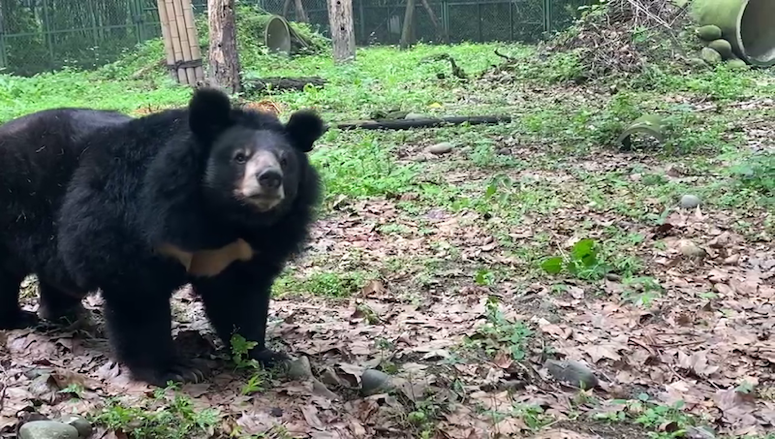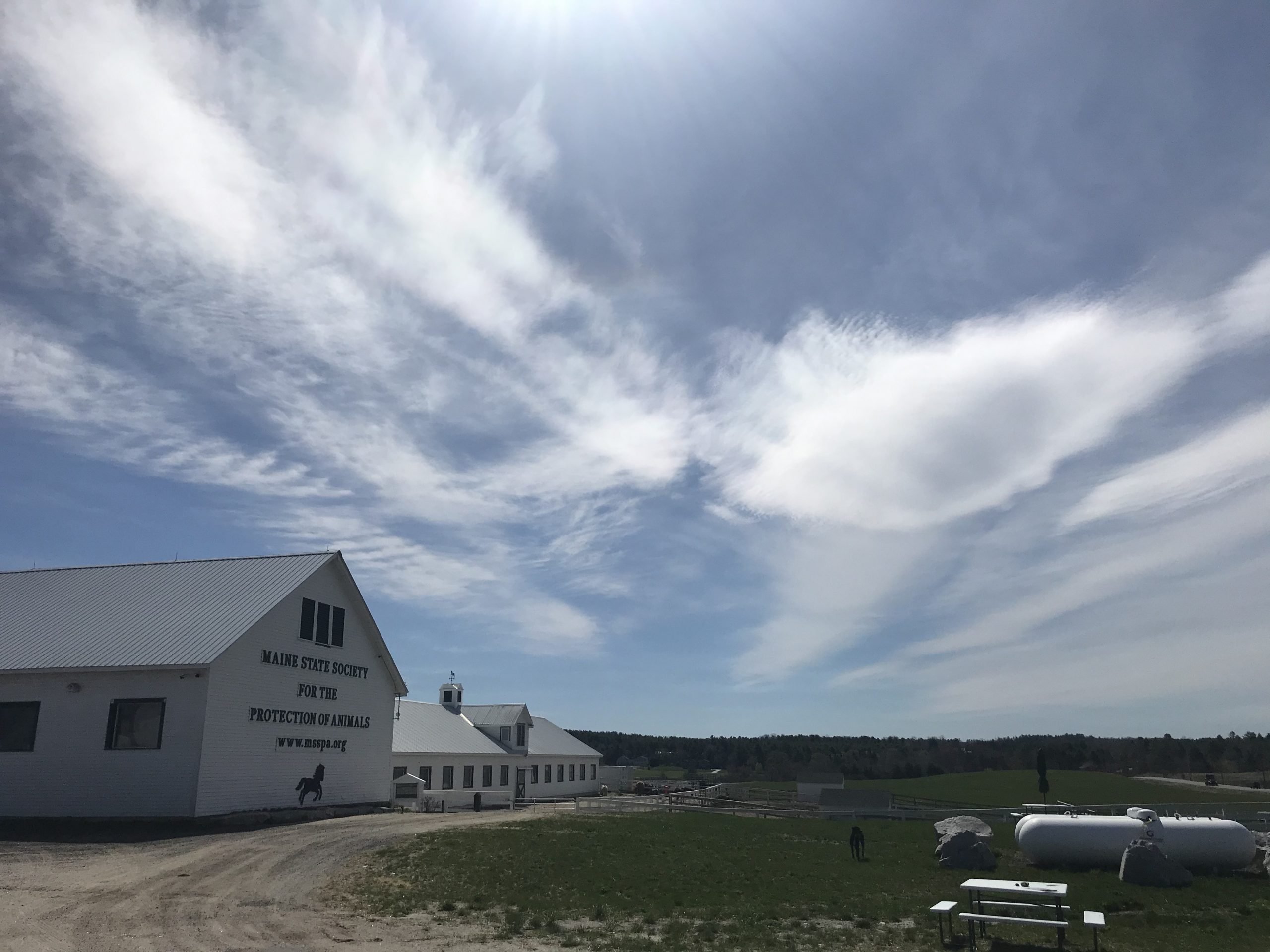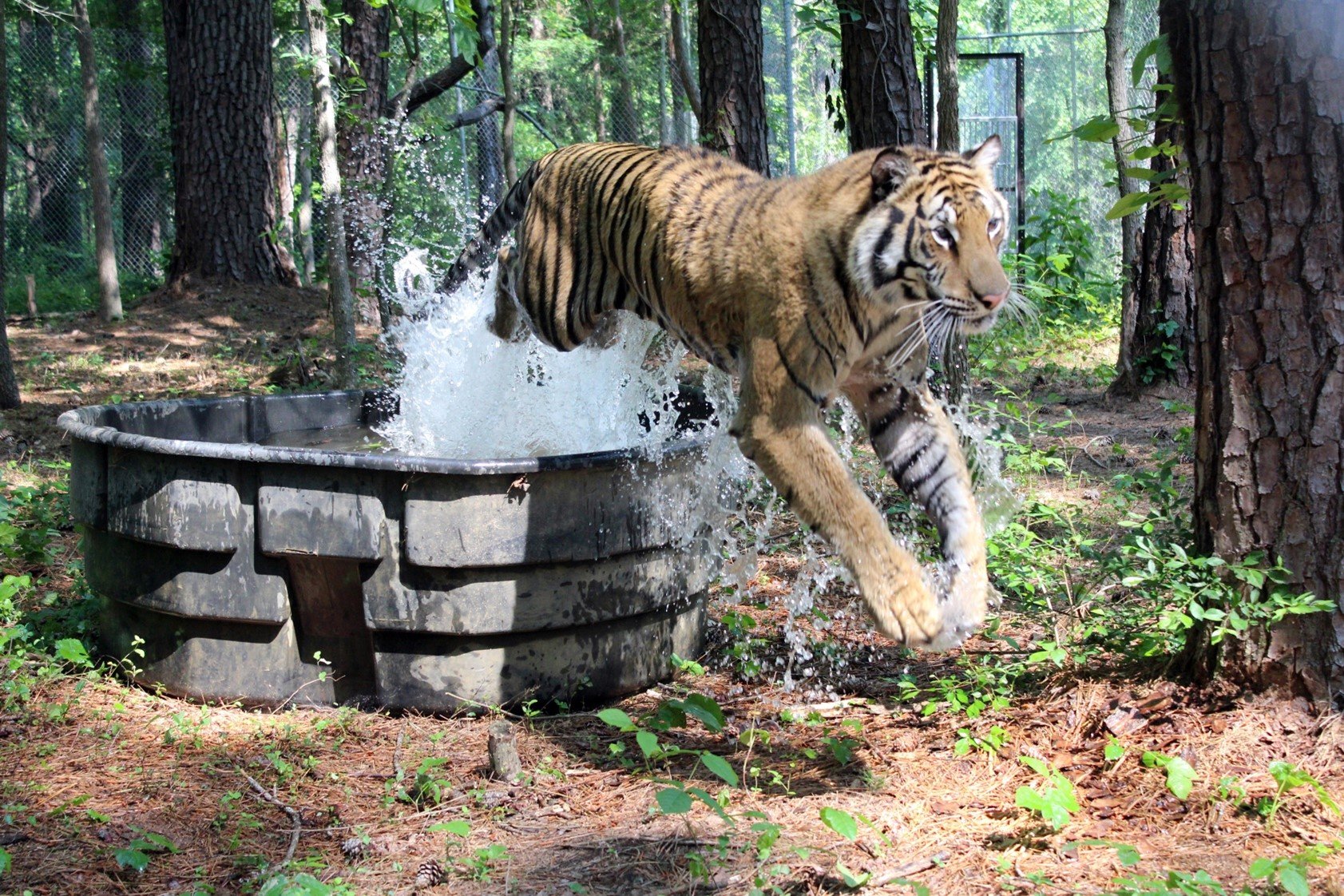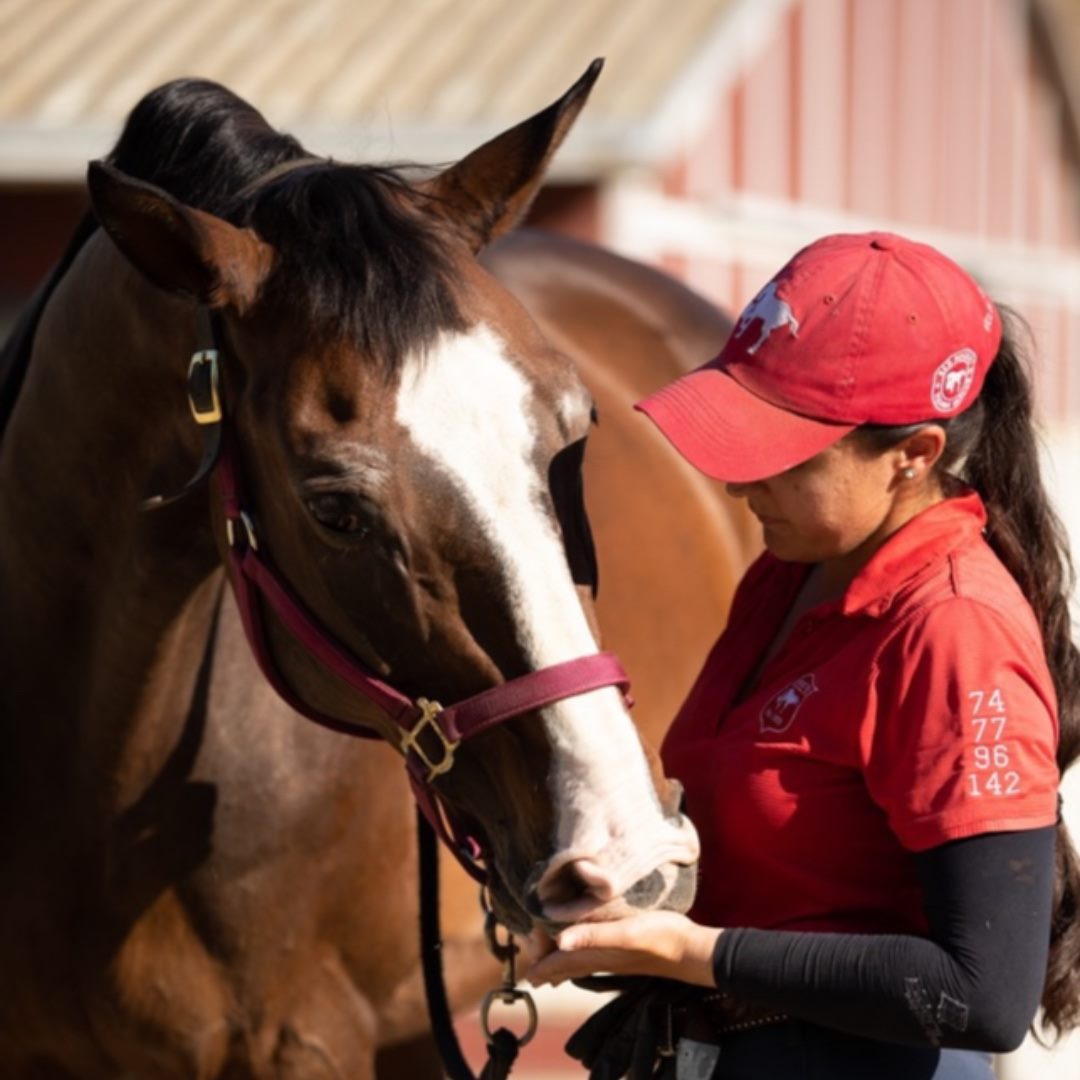Our 2020 Year in Review
Last year was challenging for all of us, but GFAS continued to help sanctuaries help animals. Our Year in Review video presents an overview of our accomplishments and celebrates the work of our members – and features some sanctuary residents as well! We’ll be sharing stories of these animals in our full annual report, which is coming soon.
Exotic Cats Removed from Tiger King Park
The US government recently seized 68 lions, tigers, tiger-lion hybrids and a jaguar from Jeff Lowe’s Tiger King Park in Oklahoma. A federal judge ordered the animals to be confiscated due to violations of the Animal Welfare Act and the Endangered Species Act including failure to provide adequate veterinary care, proper nutrition, appropriate enclosures, and shelter. The Justice Department will seek permanent forfeiture of the animals.
The animals are currently under the care of many GFAS Accredited and Verified sanctuaries including: Black Pine Animal Sanctuary, Carolina Tiger Rescue, Crown Ridge Tiger Sanctuary, Lions, Tigers & Bears, The Wildcat Sanctuary, The Wild Animal Sanctuary and Turpentine Creek Wildlife Refuge. These sanctuaries uphold the GFAS Standards of Excellence, and have the experience and expertise to provide these formerly neglected animals with a proper diet, veterinary care, enrichment items, and spacious and appropriate enclosures.
Many of these sanctuaries belong to the Big Cat Sanctuary Alliance (BCSA). The BCSA works collaboratively to advance standards of care for wild cats in sanctuaries and to eliminate the private ownership and commercial exploitation of captive big cats. In full alignment with GFAS standards, BCSA member sanctuaries do not buy, sell, breed, trade, or exploit their animals for profit, and do not offer public contact with wild animals of any age. To learn more, please visit: https://www.bigcatalliance.org/
GFAS is proud of our members that worked tirelessly to bring these long-neglected animals into their safe, and peaceful sanctuaries where they will finally be loved, respected and cared for as the wild individuals they are and no longer exploited for someone’s ego and profit. Thank you for all of your efforts and for your demonstration to the public and to the animals the meaning of true sanctuary.
Animals Asia Brings 101 Bears Home!

At the beginning of this month, Animals Asia announced big news from its accredited sanctuary in in Chengdu, China: 101 moon bears had been transferred to the sanctuary from a former bear bile farming and breeding facility, and they were finally home. Learn more about this amazing story!
Disaster Preparedness – Wildfires
 Wildfire season in the United States is here and it has started early. Although wildfires are a recurring part of nature often due to lightning strikes, most fires worldwide are started by humans accidentally or intentionally. Climate change is considered one of the key drivers influencing a wildfire season that is becoming longer and more active. Warmer spring and summer temperatures create more intense dry seasons making forests more susceptible to severe wildfires.
Wildfire season in the United States is here and it has started early. Although wildfires are a recurring part of nature often due to lightning strikes, most fires worldwide are started by humans accidentally or intentionally. Climate change is considered one of the key drivers influencing a wildfire season that is becoming longer and more active. Warmer spring and summer temperatures create more intense dry seasons making forests more susceptible to severe wildfires.
California is not the only state prone to wildfires. Wildfires are also frequent in the United States in Texas, Georgia, Florida, Montana, and Washington state. Wildfires commonly occur in many countries worldwide including Australia, Canada, South Africa and European countries of France and Italy. Many of these locations are also home to many animal sanctuaries and rescue organizations which if they are located near forested areas, un-grazed pasture lands, or public lands, being prepared for this risk is critical to protect their animals and facilities.
Wildfire disaster preparedness involves essentially two options, an evacuation plan and/or a shelter-in-place plan. The appropriate plan for your organization really depends on your location, your resources, and the number and species of animals in your care. GFAS standard S-6 addresses the need for an appropriate written disaster preparedness plan in place and the essential information posted and accessible. There are many resources available to help you prepare your disaster preparedness plan both online and in your community. California, for example has California Department of Forestry and Fire Protection (CAL FIRE) https://www.fire.ca.gov, which hosts a website that provides current information about ongoing wildfires. Ready.gov Wildfires | Ready.gov has links to early alerts and numerous other resources. Also, GFAS personnel can assist you from our resource library to develop the best plan for your specific situation.
A great video to watch titled “Saving the Ranch” can be found at the following link. https://youtu.be/31-QCHnmkYE
It is hosted by Michael Payne, DVM, PhD from UC Davis School of Veterinary Medicine. Dr. Payne is a veterinarian, ranch owner and a firefighter offering wildfire preparedness tips. Although this video primarily covers equine and farm animal ranches, many facts and tips for preparations apply to all animal facilities. It is worth it for your animals to take the 30 minutes to view it.
Pro-Tip: The Scoop on Poop
Manure Management for Farm & Equine Sanctuaries
 We know there are few people as interested in how to deal with manure as the sanctuary crowd. After all, it’s a fact of sanctuary life! Where to put it all? How to store it in such a way that it doesn’t attract pests or leach into waterways or pastures? How to construct an environmentally friendly system?
We know there are few people as interested in how to deal with manure as the sanctuary crowd. After all, it’s a fact of sanctuary life! Where to put it all? How to store it in such a way that it doesn’t attract pests or leach into waterways or pastures? How to construct an environmentally friendly system?
We sat down with Meris Bickford (CEO) and Kathy Woodbrey (Asst. CEO) of Accredited Maine State Society for the Protection of Animals (MSSPA) in Windham, Maine to learn more about how they enlisted federal conservation programs to create and fund an environmentally friendly manure management system.
Kathy: In 2015 we started investigating how we could manage run-off of effluent from two aging manure pits that were potentially contaminating the Colley-Wright Brook which runs through the MSSPA property. It was clear the nearly 40 year old manure pits needed to be redesigned and replaced. We contacted the Cumberland County Soil & Water Conservation District asking for guidance. They referred MSSPA to the USDA Natural Resources Conservation Service located in Scarborough, Maine. We contacted USDA/NRCS and staff came out to assess the situation. They determined that the manure pit redesign project fit the criteria to authorize technical and financial assistance. From there MSSPA completed a conservation program application and registered with the federal government to do business with them by obtaining a DUNS number (www.sam.gov). I will say there was a lot of paperwork to shuffle but the folks at the local office were very helpful in making sure our paperwork was complete and that we didn’t miss deadlines!
Meris: From the initial phone call to the completion of the project, the project took approximately 2 1/2 years. Because the MSSPA had no prior experience dealing with the bureaucracy of the federal system, the learning curve was steep. There were a number of deadlines in the application process that were not evident at the outset. We were fortunate that the folks at NRCS were very helpful and wanted our project to be a success.
I would advise anyone undertaking the process, which is somewhat complicated, to educate themselves about the amount of time they should anticipate from start to finish and also obtain an overview of the various funding cycles. We simply didn’t have enough experience to ask those questions at the outset.
We are planning to work with NRCS to obtain additional technical assistance and funding for the MSSPA’s forestry management plan, which was in fact funded in the same manner as the manure pit.
Kathy: Ultimately, one manure pit (the smaller of the two) was reclaimed and the second, larger pit was enlarged and rebuilt from the ground up. We now have one functioning and environmentally friendly manure pit! USDA/NRCS funding covered the cost of the approximately $60,000 project – well worth our time and effort!
To learn more about NRCS financial and technical assistance programs that could benefit your sanctuary visit: https://www.nrcs.usda.gov/wps/portal/nrcs/main/national/programs/financial/
*At the time of publication, the federal government is no longer requiring a DUNS number or registration with SAM to be eligible for these programs.
Reminder: Let Us Know About Your Volunteer Needs!
As our sanctuaries and rescue centers start to welcome back on-site volunteers and interns, we want to share the news. We have received information from a number of our members, which we are adding to a spreadsheet shared on our social media. If any members would like to include their information, please complete the short survey at this link and we’ll add it to the spreadsheet!
Featured Organizations
Summer Heats Up, and the Cats Stay Cool at
Carolina Tiger Rescue!

GFAS Accredited, Carolina Tiger Rescue in Pittsboro, North Carolina began as the Carnivore Evolutionary Research Institute in the 1970s, an organization founded by Dr. Michael Bleyman, a geneticist working to ensure the survival of key endangered species. Bleyman started a breeding program for caracals, servals, ocelots, and binturongs, but began rescuing big cats when the need for a sanctuary became apparent. The breeding program was officially ended in 2002 and later in 2009, Carolina Tiger Rescue was born.
Carolina Tiger Rescue expertly cares for several felid species and other wild animals while delivering on their mission of animal rescue, conservation education and advocacy. Guided educational tours, and summer camps shift the public’s perception of captive exotic wildlife and inform visitors about the big cat crisis in the United States. Carolina Tiger Rescue is a founding member of the Big Cat Sanctuary Alliance and a strong advocate for laws that ban private ownership of wild cats.
The sanctuary looks forward to the 2nd annual Tiger Day 5k fun run starting July 22nd and wrapping up with a virtual celebration on July 29th for International Tiger Day. To learn more, please visit: carolinatigerrescue.org
Pasado’s Summer Splash!
Summer is finally here. What could be better than a pool party with all your friends? How about a pond party?! This month Accredited Pasado’s Safe Haven in Washington finished construction of their new duck pond. Needless to say, their aquatic residents were thrilled, especially their two special needs ducks, Draco & Nemo! Check out the video below to see their inaugural swim – these happy birds made us smile.
Providing a place to swim, wade, dive and engage in natural behaviors is an important part of sanctuaries meeting the needs of their aquatic bird residents. Pasado’s continues to offer fantastic amenities to sanctuary residents with an eye on continual self-improvement. Next up: adding plantings all around the pond for even more natural space.
Aside from providing lifetime sanctuary to farmed animals, Pasado’s serves domestic cats and dogs while engaging in extensive advocacy and humane education programming for issues affecting all species. To learn more about their work, visit https://www.pasadosafehaven.org/
Red Bucket Equine Rescue in California
 When it comes to branding, GFAS Accredited Red Bucket Equine Rescue in Chino Hills, CA excels. This organization has created a rich visual identity that is incorporated in their logo, tee shirts and hats, the paint on their barn, halters on their equines, signage, and of course, their red feed and water buckets. Put all of these elements together, Red Bucket Equine Rescue conveys a readily identifiable image that supporters and donors recognize and remember who they are. This cohesive branding and messaging are a direct reflection of the cohesive teamwork provided by volunteers. Dedicated to rehabilitation, retraining and rehoming, the Red Bucket Field Support team works with potential adopters to ensure a successful transition for each horse. Their website states, “Our program removes obstacles and provides tools…”.
When it comes to branding, GFAS Accredited Red Bucket Equine Rescue in Chino Hills, CA excels. This organization has created a rich visual identity that is incorporated in their logo, tee shirts and hats, the paint on their barn, halters on their equines, signage, and of course, their red feed and water buckets. Put all of these elements together, Red Bucket Equine Rescue conveys a readily identifiable image that supporters and donors recognize and remember who they are. This cohesive branding and messaging are a direct reflection of the cohesive teamwork provided by volunteers. Dedicated to rehabilitation, retraining and rehoming, the Red Bucket Field Support team works with potential adopters to ensure a successful transition for each horse. Their website states, “Our program removes obstacles and provides tools…”.
Red Bucket Equine Rescue was established in 2009 but moved to their own ranch in 2012. On average, more than 100 equines are under their care at any one time. For more information about Red Bucket Equine Rescue, visit https://redbucketrescue.org/.
GFAS Certifications and Renewals
Over the past month, GFAS has renewed three organizations.
Renewals
End of the Trail Horse Rescue, Colorado
Serenity Farm Equine Sanctuary, Virginia
Turpentine Creek Wildlife Refuge, Arkansas
